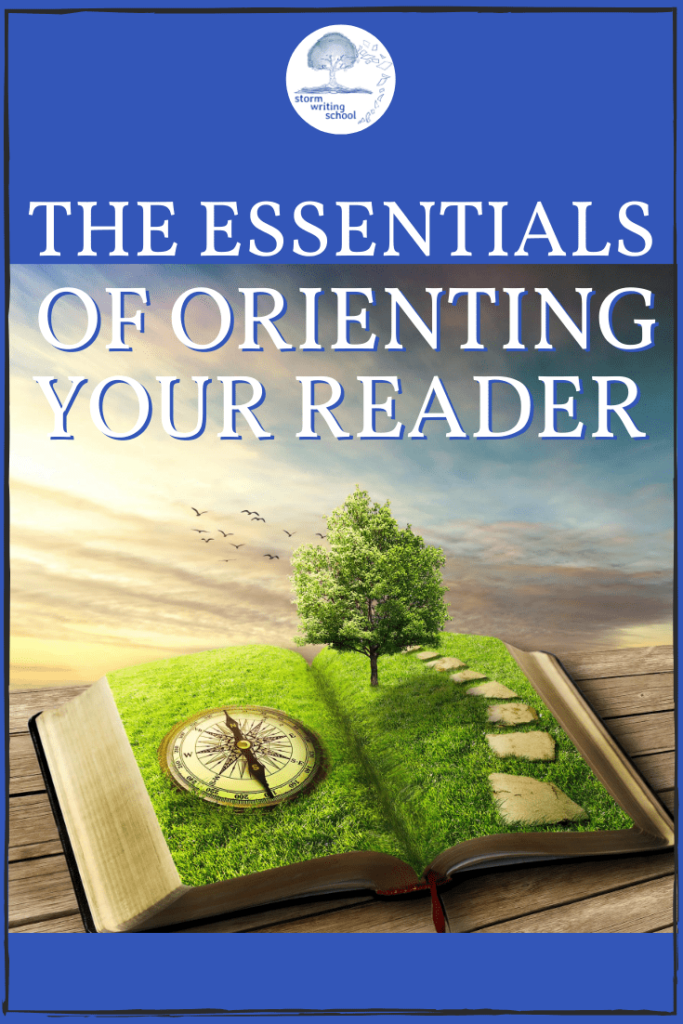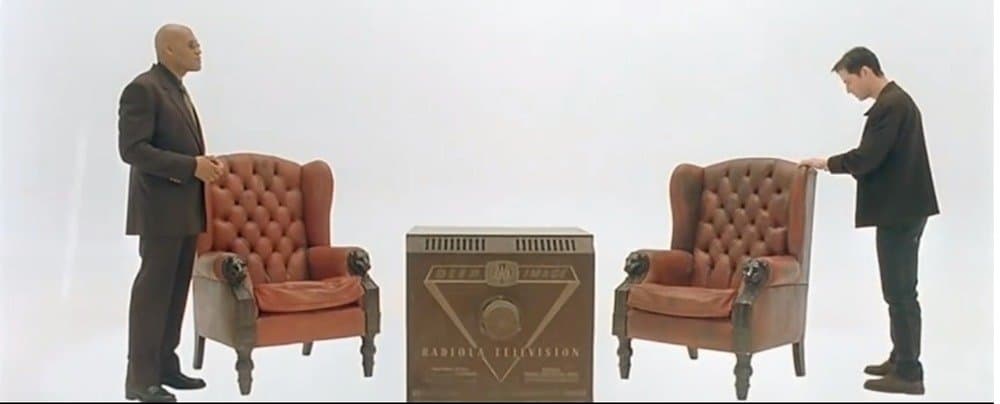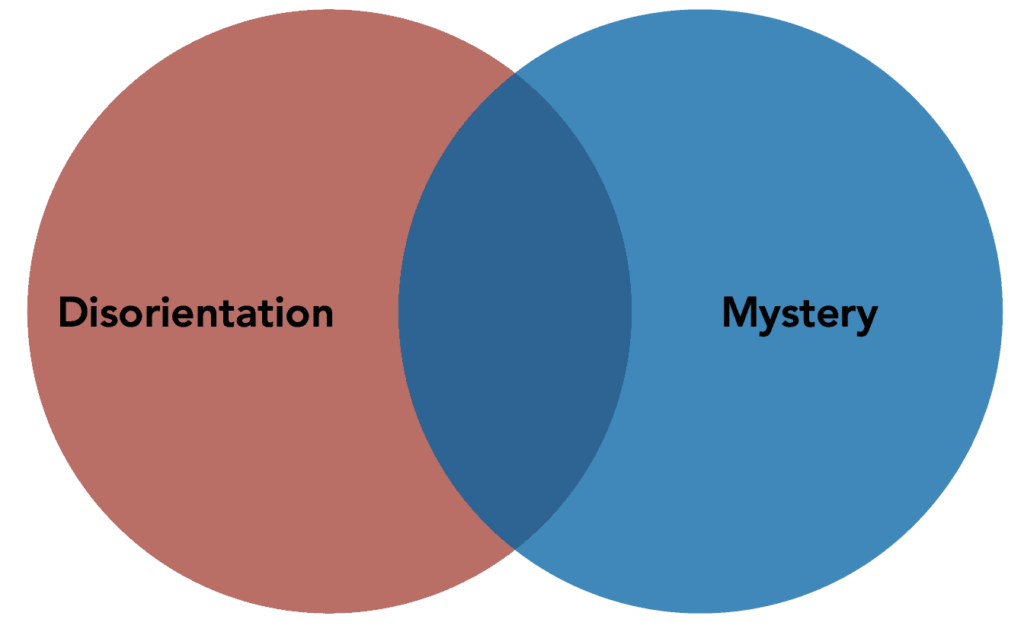The Construct
Proper orientation to stories is something we don’t talk about enough. There’s so much emphasis on getting right to character or right to the action; I’ve seen a lot of writers skip over establishing the key facets of the who/what/where/when of the scene.

In The Matrix, there’s a virtual world called “the construct,” which the main characters use to train Neo for navigating and fighting inside the actual matrix. When they enter the construct, their entire surrounding is a white void. There’s nothing there at all, just pristine bright whiteness. Then the “operator” calls up a program of some sort, and suddenly the white space is replaced by a city or a dojo or a ridiculously large armory.

I sometimes think of prose fiction—especially the very first page of the book and of subsequent changes in setting—as the construct. It’s unpopulated white space.
Readers Formulating the Construct
When we read that Sarah took a sip of her sparkling water in a can and said, “Nice day, huh?” I have a fuzzy image of Sarah, an even fuzzier image of the formless person she’s talking to, and a pretty solid image of a can of LaCroix.
I have some guesses about where a woman drinking sparkling water would observe that it’s a nice day. And subsequent lines of dialogue will help me confirm or deny whether my initial guesses were correct.
But by the fourth, fifth, sixth lines of dialogue in this scene, I’m going to be frustrated and distracted if I have to recalibrate the construct I’ve been populating in my own mind. A writer gains nothing by surprising me with basic facts about the setting: for instance, that it’s nighttime rather than mid-day and that we’re in a hospital rather than a gym or a park and that there are actually four characters in this scene rather than two.
You want to efficiently inform your readers of the backdrop against which the action is playing out so that readers can focus on the action/interaction/reaction happening in the scene.
Prose is not film. In film, orientation is almost immediate. In prose, orientation requires ink.
Mystery vs. Disorientation
But isn’t mystery good, you might ask. Doesn’t it add tension and intrigue to leave the reader on the back foot for a little while?
Yeah.
But look, there’s a difference between mystery and disorientation. Actually, this is one of those many situations in which a Venn diagram is in order:

An example of a mystery that isn’t disorienting: It’s the middle of the night, and a girl in a prom dress is running down an empty suburban street with tears in her eyes.
We don’t know why the girl is running, why she’s wearing a prom dress, why she’s crying; we don’t know how she got to where she is, whether she’s being pursued, what time period it is.
There’s plenty of mystery. But we know who we’re dealing with, when it’s happening, where it’s happening, and what’s happening.
Are we disoriented? If so, it’s a pleasant disorientation. (See the darker blue overlap between the two circles above.)
But we can take disorientation too far. Here’s a non-definitive list of some of the things I see commonly:
- Unclear attribution
- Too much jargon
- Vague pronoun/antecedents
- Changing names (first name/last name)
- Change in location we didn’t track
- Change in time we didn’t track
- Unclear cast (we’re not sure who exactly is in the scene and who isn’t)
- Verb tense shifts
The Orientation Guidelines
Now, of course, every writing “rule” can be broken. Every writing teacher’s attempt to shepherd writing craft into a corral is only going to be partially successful because the fences have big gaps and holes in them. So I hesitate to call these “requirements.” They’re more like guidelines. And they’re based on my many hours of being inadequately oriented to stories I’ve edited.
I think the reader should be pretty quickly attuned to four things at all times:
- When the scene is taking place
- Where the scene is taking place
- Who is in the scene
- What the characters are doing
But let’s dig into these four guidelines a bit.
When
While we need a general sense of when, we don’t necessarily need precision in when. A rough sense of the time period is what’s necessary.
When I say “time period,” I mean two things. First of all, we should have a sense of the story’s historical time period. Is this modern day? The 80s? The roaring 20s? Medieval times?
But I’m mostly talking about the time of day and the relative temporal position of the scene in relation to others. The baseline assumption from readers is that we’re proceeding in linear chronological sequence. But most stories will break that linearity at some point.
We need to know if you’re breaking with the chronological sequence.
And at the start of any new scene or chapter, we need to know if we’re in the very next moment (the default assumption) or if we’ve jumped forward or backward in time, and if so, by how much. (For more on time digressions, click here.)
Where
While we need a general sense of surroundings, we don’t need the name of the location or its GPS coordinates. I’m not just joking about that; I mean we don’t need to know how the setting of the scene is positioned globally in relation to everything else in the story.
Eventually, we should probably know of that global positioning, but at the start of any scene, we just need an idea of where the characters are in space.
You can leave a lot of mystery, especially if such mystery is important to the scene. A character wakes up in a dark, cold enclosure. But he can hear a rhythmic thumping and see an occasional reddish light. He figures out he’s in a trunk of a car. He might not know whose car he’s in, where they’re headed, etc. But that basic spatial orientation to his situation is essential.
Who
We need to know who we’re dealing with and how many people are in the scene (discernible from whatever POV you’ve chosen). We don’t need to know everyone’s appearance (and I would argue we don’t even need to know much about the appearance of the main character(s)). A salient trait or two is all we need; such traits allow readers to categorize characters and distinguish them as discrete entities.
We don’t need names, ranks, social statuses, but we should have a sense of their relationship to others.
What
Again, what’s important here is that you allow the reader to populate the construct with some imagery. We don’t need to know everything the character knows about what they’re doing. For instance, if a character is operating a machine or vehicle of some sort, we don’t need their understanding of that operation. We just need to see that they’re operating it and have an idea of what they’re accomplishing.
And if this particular vehicle is something fantastical or otherworldly, that’s not a problem. But it does need to be relatable to something we already know.
In his Wonderbook, Jeff Vandermeer gives an example of action described with far too much jargon, which leaves us completely disoriented:
Space Captain Talking Penguin quarked the 4G switch on his barkolater with his ghost melanges, and on came the entire starboard system, including the psi-beaker app.
Why and How
I want to emphasize that though the reader will eventually come to have theories about why and how a character has acted the way they acted, the why and how of the story are a long game. That is, at any given moment within the story, why and how can be a mystery.
One might even argue that the reader’s experience of the story has a lot to do with gradually piecing together the why and how of the characters(s) (re)actions.
In terms of orientation, however, the why and how are not that important.
Excess Orientation
What I’ve discussed so far has to do with a lack of orientation. That’s by far the more common problem I see in my editing. But occasionally, I’ll come across a story that takes too many pains to detail everything within a scene. We probably don’t need to know, for instance, that a character reached out with his right hand and took hold of a salt shaker standing in the middle of the table to the left of the pepper shaker . . .
For more on this phenomenon of hyperdetailing, see my article on The Problem with Show, Don’t Tell.
Conclusion
If you’re watching a film or a TV show, you can figure out the essentials of when, where, and who within a fraction of a second in most cases. But in prose fiction, that information is not immediately accessible to readers.
In your head as the writer, you know all this information, but the reader doesn’t. So you can sometimes forget to inform us of these basics.
I admit that the line between mystery and excessive disorientation is not always clear. But that’s what readers and editors are for. If you fear that you’re disorienting us, then get an opinion from someone willing to give an honest and insightful read.





5 Responses
I like the discussion of mystery vs disorientation. I think a lot of authors confuse confusing readers with creating mystery (pun intended). Interesting read.
I’m here for the Venn diagrams! Love a good Venn diagram, and this one was particularly good, so I think I’ll come here for all my future Venn diagram needs. Great piece, I said while scratching the itchy spot on my thigh to the left of its third largest mole.
I have a folder on my computer labeled Venn Diagrams. Love ’em!
Tim, thank you for another great post. I love the Construct comparison and the way you distinguish disorientation and mystery. As you say, so much writing advice casts us headlong into the action before basic details are established, and thus the impact of that action is not what we would desire anyway. I’ve certainly learned things here–thank you for laying it out so clearly.
Thanks, Jimmy!